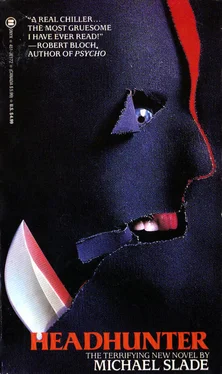"You're looking for me?" a voice asked from the door behind DeClercq.
"Am I?" the Superintendent asked, starting around.
"Yes," the man in the doorway said. "Somebody moved my hat and I think it was you. It was put down exactly the way it was found, only reversed around. Shows a person of precision, distracted by other things."
"Well, I declare. You must be the great Sherlock Avacomovitch," DeClercq said with a smile. "I've heard of you."
"Hello, Robert," the Russian said. "Long time no see. How about some breakfast? My treat."
"You're on," the Superintendent said — and that was the moment he saw it. Strange that he had not noticed the fact before; it was a detail of importance. He had been looking at Joseph Avacomovitch, having just turned from the window, and in that turning his eyes had brushed over the wall with the photographs of the two heads on the two poles and had then touched on Portman's picture. The section of corkboard reserved for the last crime was just off to the right of the door. It took about a second for the connection among the three pictures to register on his mind. Then his thoughts turned inward.
Avacomovitch was too sharp a man not to notice the signs. "What just struck you, Robert?" he asked of the Superintendent.
DeClercq was a moment coming around, then he pointed at the pictures of all three victims.
"Notice anything?" he asked the scientist.
For a moment the Russian thought. Then he nodded his head. "Yes. All three women have raven black hair."
Joseph Avacomovitch's background was unique.
He had been born in the Russian Ukraine of parents who worked on a rural collective. Both were slaughtered during the Nazi advance on Stalingrad when the boy was fourteen. Avacomovitch had been brought up by the state and selected early because of his academic brilliance for a first-class Soviet education. By the early 1960s when he was in his thirties he held four university degrees and was a leading forensic scientist in the Soviet Academy of Sciences. Even then, the techniques that he developed were being recognized and picked up for use in the West.
In 1963 Moscow had sent him to the city of East Berlin. Shortly after President John F. Kennedy had made his statement " Ich bin ein Berliner!" to the ecstatic response of West Germans, the East German police had been confronted by a baffling series of homosexual slayings. In each case a middle-aged German man had been found sodomized and strangled, with both hands tied by rope to the sides of the neck. In the clutched hand of the fifth victim had been found a button from a Soviet soldier's uniform. The day that this news leaked out the East German Army had had to crush an anti-Russian riot. That night there had been a sixth victim, minutes before Avacomovitch had arrived.
It took the Russian scientist fourteen hours to break the case. He did it by examining a rope.
The first five murder victims had been found indoors. But the last one had been different. It had the same MO of sexual assault, trussing, and strangulation — but a second rope had been looped about the neck and the corpse tossed out through a fifth floor window above a darkened street.
Every rope has properties peculiar to its fibers. Avacomovitch found several points of fiber rotation twist. Then he discovered at the points of the twist flakes of either car paint or chrome plate. After two hours' work by chromatography he had isolated the vehicle year and make. It was a Nazi Volkswagen, vintage 1943.
Two hours after that East German Motor Vehicle Records had found the registration, for after the Soviet bombardment of East Berlin at the close of the Second World War there had not been that many intact Nazi vehicles left. Then an hour and a half later an East German was arrested. The KGB linked him to the American CIA. Avacomovitch linked him to the body hanging from the window. Then the case itself was closed — and passed on to Propaganda.
The points of stress and the location of the paint and chrome deposits on the rope used to hang the sixth victim indicated that the same rope had been tied around the vehicle's roof rack and then run down the back of the car and wound several times around one side of the bumper.
When the East German agent of the CIA had been arrested, an examination of his car revealed that one of two ropes used to support the right rear bumper had recently been removed and had gone missing. It was unfortunate, however, that the man never came to trial and that Joseph Avacomovitch was once more denied an opportunity to test his precision in a case. Inexplicably, the man had suffered a heart attack under KGB questioning — but not before he had blown a network of seventeen NATO spies.
The next day all seventeen were summarily shot and it was announced in Moscow that forensic scientist Joseph Avacomovitch had been awarded the Order of Lenin for his deductive achievement.
The day after that Avacomovitch defected to West Berlin.
* * *
After his defection to the West in 1963, Avacomovitch had been debriefed in London by both British and American Intelligence Units. After that he had been offered a sizable "resettlement" fee. He had chosen to move to the Canadian prairies and was reported to have given this as his reason: "I long to return to the Ukraine in the years of my early childhood. That I cannot do, but this land serves my purpose. This land is like Russia — minus the Russians."
Two days after Avacomovitch set foot on Canadian soil in the city of Calgary, Alberta, the RCMP — ever pragmatic when it came to top-notch personnel and well aware of his forensic exploits — had offered the Russian emigre a non-security-access laboratory appointment. From then on Joseph Avacomovitch was employed on Her Majesty's Service — and five years later he was granted Security Clearance.
DeClercq and Avacomovitch had first worked together in Montreal in 1965. One night that November, with baby Jane sitting on his knee, Robert DeClercq had asked Joseph Avacomovitch the reason for his defection. "That's if you don't mind telling," he said.
It was after dinner and they were sitting, the four of them, Robert, Kate, Joseph and Jane, in front of a cracking fire while the snow once more tumbled down beyond the frosted windows. Old Man Winter already had one icy toe in the door.
"I don't mind," the Russian said, "it's all a matter of record. The reason's half political and half academic."
Avacomovitch took a sip of cognac, then rolled the glass in his very large hands.
"The political part is straightforward. I was never a member of the Communist Party at heart and I didn't believe in the system — although it was good to me. One look at East Germany and I knew I wanted to go. Besides, except for position I had nothing to leave behind." He smiled down at Jane who was rapidly falling asleep.
"But it was really intellectual incentive which gave me the mental push." Avacomovitch looked from the baby directly at Robert DeClercq. "When I was involved in studies toward my final two degrees, we were encouraged to pore over all the classic works on famous Western murderers. The official line was that they revealed the sickness in bourgeois society. The ones who intrigued me most of all were the killers who slaughtered for no other reason than the fact they enjoyed it
The Germans have a word for this — they call such a motive Lustmord.
"Now it just so happens that we don't have such murderers in the Soviet Union. At least not that I could hunt — and that's a realistic fact. Those with the lustmord instinct are recognized early in that country and channeled into the Secret Police. Their aggression is utilized, and as a group of natural killers they are jealously protected like an endangered species."
Читать дальше










